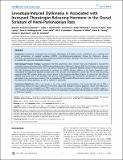Levodopa-Induced Dyskinesia Is Associated with Increased Thyrotropin Releasing Hormone in the Dorsal Striatum of Hemi-Parkinsonian Rats
Author(s)
Cantuti-Castelvetri, Ippolita; Keller-McGandy, Christine E.; Kett, Lauren R.; Landy, Alex; Hollingsworth, Zane R.; Saka, Esen; Crittenden, Jill R.; Nillni, Eduardo A.; Young, Anne B.; Standaert, David G.; Graybiel, Ann M.; F. Hernandez, Ledia; ... Show more Show less
DownloadCantuti-2010-Levodopa-Induced Dyskinesia Is Associated with Increased Thyrotropin Releasing Hormone in the Dorsal Striatum of Hemi-Parkinsonian Rats.pdf (749.2Kb)
PUBLISHER_CC
Publisher with Creative Commons License
Creative Commons Attribution
Terms of use
Metadata
Show full item recordAbstract
Background
Dyskinesias associated with involuntary movements and painful muscle contractions are a common and severe complication of standard levodopa (L-DOPA, L-3,4-dihydroxyphenylalanine) therapy for Parkinson's disease. Pathologic neuroplasticity leading to hyper-responsive dopamine receptor signaling in the sensorimotor striatum is thought to underlie this currently untreatable condition.
Methodology/Principal Findings
Quantitative real-time polymerase chain reaction (PCR) was employed to evaluate the molecular changes associated with L-DOPA-induced dyskinesias in Parkinson's disease. With this technique, we determined that thyrotropin releasing hormone (TRH) was greatly increased in the dopamine-depleted striatum of hemi-parkinsonian rats that developed abnormal movements in response to L-DOPA therapy, relative to the levels measured in the contralateral non-dopamine-depleted striatum, and in the striatum of non-dyskinetic control rats. ProTRH immunostaining suggested that TRH peptide levels were almost absent in the dopamine-depleted striatum of control rats that did not develop dyskinesias, but in the dyskinetic rats, proTRH immunostaining was dramatically up-regulated in the striatum, particularly in the sensorimotor striatum. This up-regulation of TRH peptide affected striatal medium spiny neurons of both the direct and indirect pathways, as well as neurons in striosomes.
Conclusions/Significance
TRH is not known to be a key striatal neuromodulator, but intrastriatal injection of TRH in experimental animals can induce abnormal movements, apparently through increasing dopamine release. Our finding of a dramatic and selective up-regulation of TRH expression in the sensorimotor striatum of dyskinetic rat models suggests a TRH-mediated regulatory mechanism that may underlie the pathologic neuroplasticity driving dopamine hyper-responsivity in Parkinson's disease.
Date issued
2010-11Department
Massachusetts Institute of Technology. Department of Brain and Cognitive Sciences; McGovern Institute for Brain Research at MITJournal
PLoS ONE
Publisher
Public Library of Science
Citation
Cantuti-Castelvetri, Ippolita et al. "Levodopa-Induced Dyskinesia Is Associated with Increased Thyrotropin Releasing Hormone in the Dorsal Striatum of Hemi-Parkinsonian Rats." PLoS ONE 5(11): e13861.
Version: Final published version
ISSN
1932-6203